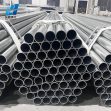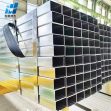Basic Knowledge of Curtain Wall
What Is A Curtain Wall?
Curtain walls are a building cladding system widely used for decades to enhance the aesthetics of structures and to provide a secure building envelope against the elements outside. The term “curtain wall” refers to a non-structural exterior wall that does not support loads other than its own weight, often consisting of large expanses of glass or lightweight metal panels. The structural load of curtain walls is transferred to the supporting structure at the anchorage points, generally at the concrete or steel structural components, such as columns or structural slabs.

Curtain Wall Component
Curtain walls consist of two basic components: curtain wall frame and the infill curtain wall panels (typically made of glass or metal). How these two elements are constructed, including the anchorages, properties, and proportions in which establishes the essential difference between the individual curtain wall systems. The most commonly utilized frame systems are:
•Point-loaded structural glazing systems
•Unit mullion systems
•Unitized systems
•Column cover and spandrel systems
•Stick systems
These curtain wall frame systems are typically made of steel, aluminum, multi-laminate glass, or other resilient materials. The frame provides the support grid that holds the infill panels in place and connects the system to the building’s structural slabs and/or columns.
High-Rises, Elevators & Innovation Of Curtain Walls
The development of elevator conveying systems in the late 1800s was one of the incentives that drove the construction of high-rise buildings. With the advances in utilizing structural steel and reinforced concrete as building materials, designers no longer were required to rely on an exterior wall system to support the structure of the building. As a result, buildings became taller and lighter. This opened the door to many different designs to the system, and the ways in which curtain wall structures were mounted and fixed to the building. With advancements in building construction, sheet metal and aluminum are now more frequently used as curtain wall frames in lieu of steel.
Installation & Maintenance Of Curtain Walls For Better Performance
If you would like to keep the curtain wall in good condition in a long run, you should consider a plan of the proper installation and a proactive, ongoing maintenance in advance because it can help you reduce the risk of those bigger headaches. Specifically speaking, a good maintenance plan should include routine inspection, regular cleaning, prompt repair of minor problems, and written records of maintenance activity to keep you on track. Moreover, in addition to removing years of accumulated damage to glass and other curtain wall materials, proactive maintenance will preserve the beauty and value of your curtain wall facade system, and save you money over the long haul, along with appealing to existing and potential tenants.
Tel: +86 18202256900 Email: steel@fwssteel.com










